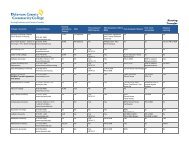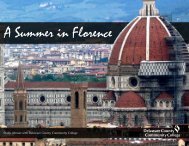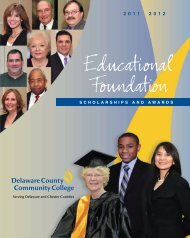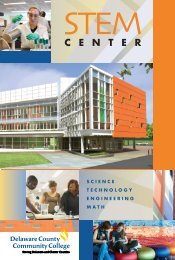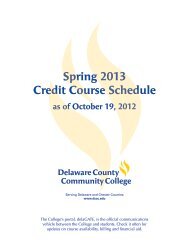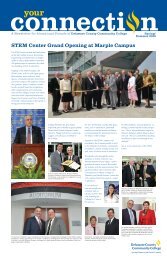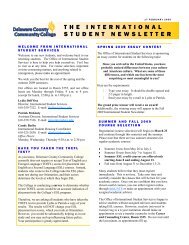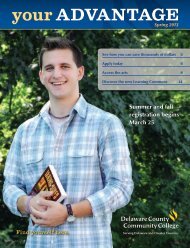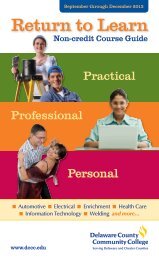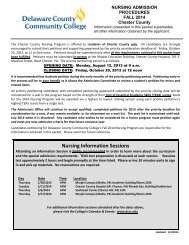2010 Catalog - Delaware County Community College
2010 Catalog - Delaware County Community College
2010 Catalog - Delaware County Community College
Create successful ePaper yourself
Turn your PDF publications into a flip-book with our unique Google optimized e-Paper software.
106 COURSE DESCRIPTIONS<br />
• Describe the process through which a student may<br />
become eligible to receive special education services<br />
• Describe the types of services and resources that students<br />
with disabilities may receive and the settings in which<br />
they may receive them.<br />
• Name the components of an individualized<br />
Education Program<br />
• Understand the differences between high incidence and<br />
low incidence disabilities<br />
• Demonstrate an understanding of how to adapt<br />
instructional materials for students with disabilities<br />
• Identify significant events that have shaped this history of<br />
special education law and teaching methods<br />
• Explain the uses of different types of assessments<br />
• Develop the ability to evaluate and assess students’ needs<br />
• Analyze a classroom environment for effective teaching<br />
practices in meeting the diverse needs of special<br />
populations<br />
• Obtain additional field experience and utilize it to<br />
complete course requirements<br />
• Create products for an e-portfolio<br />
Prereq. PSY 140, ENG 112<br />
3 Credits 3 Weekly Lecture Hours<br />
EGR 100<br />
(EGR) Engineering<br />
Engineering Graphics<br />
The fundamentals of drafting, space geometry of points,<br />
lines and surfaces, graphs, graphical mathematics and<br />
design projects.<br />
Upon successful completion of this course, students<br />
should be able to:<br />
• Reduce concepts and configurations to freehand sketches.<br />
• Construct orthographic drawings using drafting<br />
standards, conventions and instruments.<br />
• Construct pictorial and axonometric instrument drawings.<br />
• Solve descriptive geometry problems.<br />
• Apply the principles of graphic mathematics to scales,<br />
graphs, nomograms, empirical equations and Graphical<br />
calculus.<br />
• Create and plot computer-aided drawings.<br />
• Solve individual and group preliminary design projects.<br />
Prerequisite: MAT 140 or satisfactory score Math Placement<br />
test score<br />
3 Credits 2 Weekly Lecture Hours<br />
2 Weekly Laboratory Hours<br />
EGR 150<br />
Engineering Topics<br />
This course is a required series of eight seminars<br />
designed to introduce first year engineering students to<br />
skills and topics of importance in engineering and is taken<br />
in the second semester of the engineering curriculum.<br />
Presented by both DCCC faculty/staff and invited speakers,<br />
the weekly one-hour seminars cover technical writing and<br />
communication, research design, error analysis and<br />
internet research, along with presentations by practicing<br />
mechanical, chemical, electrical and computer engineers.<br />
Upon successful completion of this course, students<br />
should be able to:<br />
• Use the Internet as a research tool in engineering.<br />
• Write a concise and accurate technical abstract on an<br />
engineering topic in an appropriate style.<br />
• Propose a research design for a specific engineering<br />
problem.<br />
• Explain how error analysis may be applied to a specific<br />
engineering problem.<br />
• Discuss the role of engineers in the current and future<br />
economic and technological environment.<br />
• Describe the technical areas in which practicing engineers<br />
work.<br />
• Clarify general or specific career goals in engineering.<br />
Prerequisite: ENG 050 and REA 050<br />
1 Credit 1 Weekly Lecture Hours<br />
EGR 200<br />
Engineering Mechanics I<br />
A vector mechanics study of forces acting on static<br />
particles and rigid bodies. Equilibrium of rigid bodies,<br />
distributed body forces acting on centroid, centers of<br />
gravity and moments of inertia, analysis of structures,<br />
forces in beams and cables, friction and virtual work are<br />
topics covered.<br />
Upon successful completion of this course, students<br />
should be able to:<br />
• Resolve forces acting in plane and space configurations.<br />
• Develop equivalent-force systems by means of vector, dot,<br />
cross and triple products.<br />
• Solve equilibrium problems on two- and threedimensional<br />
bodies.<br />
• Determine the effect of distributed forces on bodies in<br />
terms of center of gravity and moment of inertia.<br />
• Analyze the internal forces on structures such as trusses,<br />
frames, machines, beams and cables.<br />
• Investigate the friction between moving components on<br />
mechanisms such as wedges, screws, bearings, wheels<br />
and belts.<br />
• Use the method of virtual work to solve for forces,<br />
mechanical efficiency, potential energy, equilibrium<br />
and stability.<br />
Prereq. MAT 161 and PHY 131<br />
3 Credits 3 Weekly Lecture Hours<br />
EGR 201<br />
Engineering Mechanics II<br />
A course in vector dynamics. Topics include the kinematics<br />
and kinetics of particles and rigid bodies in plane and<br />
three-dimensional motion. Force, energy and momentum<br />
methods, as well as the study of unidirectional vibrations<br />
are covered.<br />
Upon successful completion of the course, students<br />
should be able to:<br />
• Analyze the kinematics of particles and rigid bodies for<br />
unidirectional, bidirectional and general motion.<br />
• Develop the kinetics of particles and rigid bodies in<br />
terms of force, energy and momentum for unidirectional,<br />
bidirectional and general motion.<br />
• Determine the motion of single particles and rigid bodies<br />
in one-dimensional vibrating or oscillating systems.<br />
Prereq. or Coreq. EGR 200 and MAT 261<br />
3 Credits 3 Weekly Lecture Hours<br />
EGR 210<br />
Engineering Circuits<br />
A first course in circuits for engineers. Uses the basic<br />
concepts of modern circuit analysis. Topics include twoterminal<br />
devices and their classification, circuit topology<br />
and Kirchoff's Laws, lumped-circuit analysis using matrix<br />
algebra, controlled and independent sources, power and<br />
energy, and second-order time-domain techniques<br />
(including singularity functions, convolution and introductory<br />
state-variable techniques). Theory will be illustrated by<br />
laboratory and class assignments. Upon successful<br />
completion of this course, students should be able to:<br />
• Set up and solve circuit problems using mesh analysis.<br />
• Set up and solve circuit problems using nodal analysis.<br />
• Set up and solve for the transient response of first-order<br />
and second-order circuits.<br />
• Set up and solve for the general solution of first-order<br />
and second-order circuits.<br />
• Find the initial conditions of first-order and<br />
second-order circuits.<br />
• Use instruments (DMM, power supplies, function<br />
generators, oscilloscopes) to measure various<br />
electrical quantities.<br />
• Find the impulse response of electrical circuits.<br />
• Find the response to a given input of an electrical circuit<br />
using convolution.<br />
Prereq. PHY 132, Coreq. MAT 261<br />
4 Credits 3 Weekly Lecture Hours<br />
2 Weekly Laboratory Hours<br />
EGR 220<br />
Engineering Thermodynamics<br />
Engineering Thermodynamics is an introductory onesemester<br />
course with lecture, demonstrations, and<br />
computer simulations, designed for engineering and<br />
science students. Major topics include: concepts of<br />
thermodynamics; pressure; temperature; heat and heat<br />
transfer; properties of substances; density; extensive and<br />
intensive properties; First Law of Thermodynamics and its<br />
application; Second Law of Thermodynamics and its<br />
application; reversible and irreversible processes; the<br />
Clausius, Kelvin, and Planck statements of the Second Law;<br />
entropy and Carnot, Otto, Diesel, and Rankine cycles;<br />
power cycles and the refrigeration cycle.<br />
Upon completion of this course, the student should be<br />
able to:<br />
• Understand the basic concepts and definitions needed to<br />
apply the laws of thermodynamics.<br />
• Describe the properties and behavior of a pure substance.<br />
• Develop the First Law of Thermodynamics and apply it to<br />
control volume problems.<br />
• State the Second Law of Thermodynamics and describe<br />
its significance to the analysis of cycles and processes.<br />
• Understand the concept of entropy and its relationship to the<br />
Second Law of Thermodynamics.<br />
• Analyze the operation of power and refrigeration systems.<br />
Prereq. PHY 132, MAT 161, CHE 110,<br />
– recommended MAT 261<br />
3 Credits 3 Weekly Lecture Hours<br />
(ELT) Electrical Occupations<br />
ELT 100<br />
Residential Wire I<br />
Residential Wiring I provides students with the basic<br />
skills necessary in the field of electrical construction. The<br />
course of study emphasizes the proper application of<br />
materials, safety and the National Electrical Code. The<br />
student will review math skills to prepare for calculations<br />
necessary in the electrical field.<br />
Upon successful completion of this course, students<br />
should be able to:<br />
• Explain how information is conveyed to the electrician in<br />
the field via plans and specifications.<br />
• Compute proper box sizing per the National<br />
Electrical Code.<br />
• Calculate proper electrical service requirements for an<br />
intended use.<br />
• Perform basic calculations necessary for a safe and<br />
efficient installation.<br />
• Describe basic electrical circuits.<br />
• Specify material appropriate for residential use per the<br />
National Electrical Code.<br />
• State the function of basic electrical safety devices such as<br />
ground-fault circuit interrupters and circuit breaker.<br />
• Size conductors and over current devices.<br />
4 Credits 3 Weekly Lecture Hours<br />
2 Weekly Laboratory Hours<br />
ELT 101<br />
Residential Wire<br />
The Residential Wire course is devoted to all aspects of<br />
residential wiring. Students will have the opportunity to<br />
take part in new house wiring that will include; lighting<br />
receptacles major appliances, alarm systems, telephone,<br />
television, and an electrical service. Additionally, students<br />
will learn how to wire major house additions, upgrading of<br />
a kitchen, how to wire older houses and work with ‘knob<br />
and tube’ electrical systems. This course will stress National<br />
Electric Code compliance and demonstrate proper application<br />
of materials, methods of installation that are safe and free<br />
from defects.<br />
Upon successful completion of this course, students<br />
should be able to:<br />
• Layout and install cable and make connections.<br />
• Identify cabling requirements for dedicated circuits in<br />
DELAWARE COUNTY COMMUNITY COLLEGE




